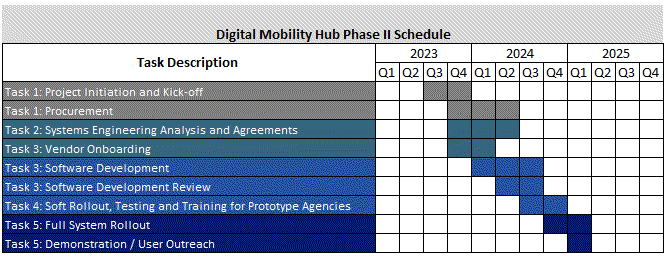Digital Mobility Hub
Digital Mobility Hub
The Colorado Department of Transportation (CDOT) is leading the development of a digital mobility hub platform to enable regional transit coordination and collaboration with transit providers that are part of the Colorado transit system. Digital Transit Mobility leverages real-time General Transit Feed Specification (GTFS) travel data sourced from rural transit providers across Colorado.
Digital Transit Mobility will begin as a pilot with the platform including centralized trip planning and ticketing across multiple transit providers. Upon a successful pilot deployment, future functionality expansion and additional partners are anticipated as the program matures and develops.
The CDOT team will leverage this website for key program information and current project status and updates.
Benefits of Digital Mobility Hub
Transit Passengers: One integrated application to plan, book, and pay for a complete trip with multiple public and private transit operators, including first- and last-mile connections and real-time transit information.
Transit Service Providers: Provide improved route planning and coordination between regional and local operators, increasing the overall efficiency of the statewide transit network.
CDOT: Improve partnerships between public and private transit providers including with Bustang, Bustang Outrider, and Snowstang operations, as well as complement CDOT’s buildout of physical mobility hubs throughout the state.
Mountain Highway System: Making transit information easier to access and use will encourage more people to choose transit, thus reducing congestion and improving safety on the state’s congested and treacherous mountain corridors, while supporting economic resiliency.
Rural Economies: Support local economic vitality by improving attractiveness of transit travel to mountain communities. Increase ease of travel to rural destinations, enhance mobility options, and improve equity of access to transit services. Encouraging more transit usage will create more capacity for the mountain corridors and maintain the attractiveness of mountain destinations.
Air Quality and Greenhouse Gas Emissions Reduction: Encourages transit ridership, which decreases congestion on highways and emissions from single occupancy vehicles.
Example User Scenarios:
- A student attending Fort Lewis College in Durango needs to travel to Denver International Airport
- A resident of Lamar needs to get to medical services in the City of Pueblo
- A worker in Grand Junction needs to travel home near Rifle or Fruita
Overview of the Project
Purpose:
-
Develop and build a centralized digital mobility hub that enables greater use of the statewide transit by connecting rural and urban transit providers
-
Utilize General Transit Feed Specification (GTFS) data for trip planning, dispatching, and online ticketing in real-time for Colorado Transit providers (especially rural providers), in-state passengers, and out-of-state visitors.
Needs and Solution:
-
Allow the public to seamlessly connect from one transit system to another in Colorado
-
Develop an easy-to-use app that allows the public to plan their entire trip and pay online, and also support coordination and data sharing between local transit providers.
Digital Mobility Hub Project Management Plan
Scope
- Task 1
- Project Initiation and Kick-off - Completed
- Procurement - Completed
- Task 2
- Systems Engineering Analysis and Agreements - In progress
- Task 3
- Vendor Onboarding - Completed
- Software Development - In progress
- Software Development Review
- Task 4
- Soft Rollout, Testing and Training for Prototype Agencies
- Task 5
- Full System Rollout
- Demonstration / User Outreach
Budget
Currently provided by FY21 CDOT Office of Innovative Mobility administrative funds.
Note: This only represents the development of the platform. Operations and maintenance may have future costs not accounted for the current budget.
Schedule

Digital Mobility Hub Partnerships & Stakeholders
This project is a collaborative effort between the Office of Innovative Mobility with support from the Office of Information Technology, Intelligent Transportation Systems, and Chief Data Office.
Prototype Partners
- Clear Creek County
- ECO Transit
- Town of Winter Park
Advisory Committee
- Advocacy Organizations and MPOs
- Colorado Association of Transit Agencies (CASTA)
- Colorado Association of Ski Towns (CAST)
- I-70 Coalition
- North Front Range MPO
- Rural transit agencies
- Bustang Outrider
- Clear Creek County (Prototype Partner)
- ECO Transit (Prototype Partner)
- Envida
- Grand Valley Transit
- Roaring Fork Transit Authority (RFTA)
- San Miguel Authority for Regional Transportation (SMART)
- Town of Breckenridge
- Town of Estes Park (Estes Transit)
- Town of Snowmass Village
- Town of Winter Park (Prototype Partner)
- Urban transit agencies
- Bustang
- Regional Transportation District (RTD)
- Mountain Metro Transit (MMT)
- Greeley-Evans Transit (GET)
- Other Interested Parties
- State of Nebraska
- Transit Plus
Local Transit Providers
Providers statewide will be given opportunities to participate in the development and testing of the Digital Mobility Hub platform.
For questions or to join the project updates email list, contact OIM at [email protected]
